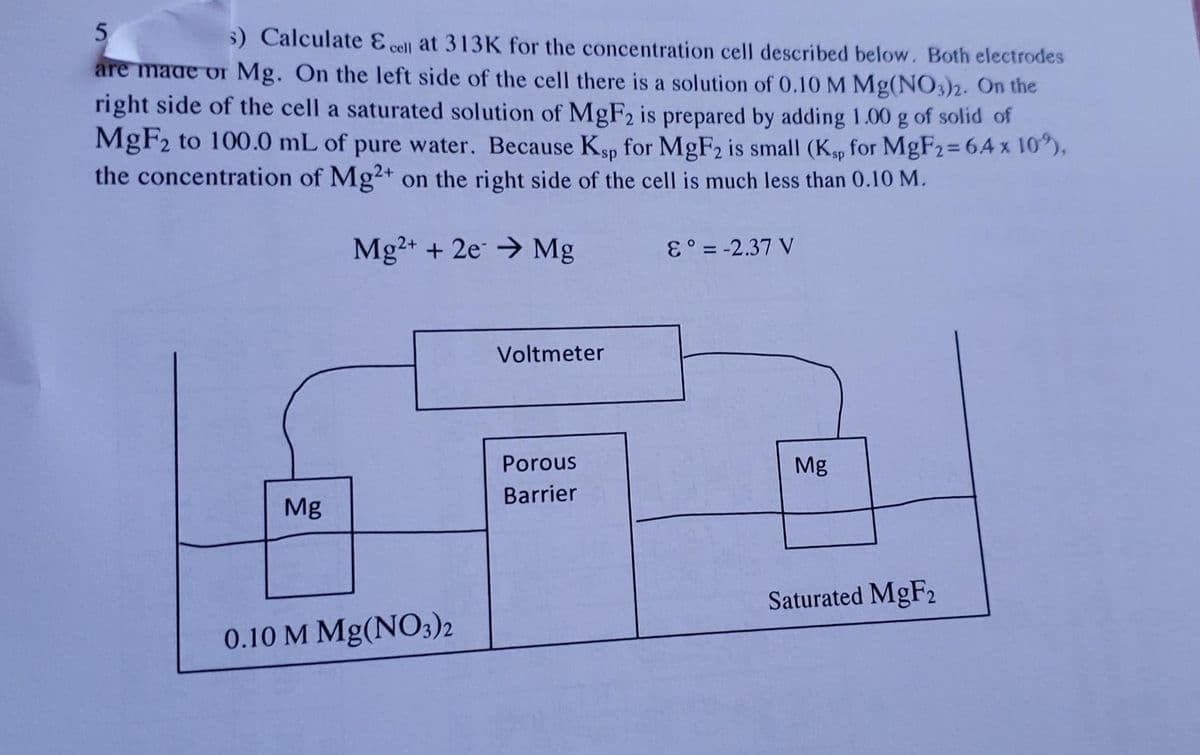5) Calculate E cel at 313K for the concentration cell described below. Both electrodes are made or Mg. On the left side of the cell there is a solution of 0.10 M Mg(NO3)2. On the right side of the cell a saturated solution of MgF2 is prepared by adding 1.00 g of solid of MgF2 to 100.0 mL of pure water. Because Ksp for MgF2 is small (K, for MgF2=64 x 10"), the concentration of Mg²+ on the right side of the cell is much less than 0.10 M. Mg2+ + 2e Mg E° = -2.37 V Voltmeter Porous Mg Barrier Mg Saturated MgF2 0.10 M Mg(NO3)2
5) Calculate E cel at 313K for the concentration cell described below. Both electrodes are made or Mg. On the left side of the cell there is a solution of 0.10 M Mg(NO3)2. On the right side of the cell a saturated solution of MgF2 is prepared by adding 1.00 g of solid of MgF2 to 100.0 mL of pure water. Because Ksp for MgF2 is small (K, for MgF2=64 x 10"), the concentration of Mg²+ on the right side of the cell is much less than 0.10 M. Mg2+ + 2e Mg E° = -2.37 V Voltmeter Porous Mg Barrier Mg Saturated MgF2 0.10 M Mg(NO3)2
Chemistry
10th Edition
ISBN:9781305957404
Author:Steven S. Zumdahl, Susan A. Zumdahl, Donald J. DeCoste
Publisher:Steven S. Zumdahl, Susan A. Zumdahl, Donald J. DeCoste
Chapter18: Electrochemistry
Section: Chapter Questions
Problem 125AE
Related questions
Question
100%

Transcribed Image Text:5
5) Calculate E cell at 313K for the concentration cell described below. Both electrodes
are made or Mg. On the left side of the cell there is a solution of 0.10M Mg(NO3)2. On the
right side of the cell a saturated solution of MgF2 is prepared by adding 1.00 g of solid of
MgF2 to 100.0 mL of pure water. Because Ksp for MgF2 is small (Kp for MgF2=64 x 10"),
the concentration of Mg2+ on the right side of the cell is much less than 0.10 M.
%3D
Mg2+ + 2e → Mg
E° = -2.37 V
Voltmeter
Porous
Mg
Barrier
Mg
Saturated MgF2
0.10 M Mg(NO3)2
Expert Solution
This question has been solved!
Explore an expertly crafted, step-by-step solution for a thorough understanding of key concepts.
Step by step
Solved in 2 steps with 1 images

Knowledge Booster
Learn more about
Need a deep-dive on the concept behind this application? Look no further. Learn more about this topic, chemistry and related others by exploring similar questions and additional content below.Recommended textbooks for you

Chemistry
Chemistry
ISBN:
9781305957404
Author:
Steven S. Zumdahl, Susan A. Zumdahl, Donald J. DeCoste
Publisher:
Cengage Learning


Chemistry: An Atoms First Approach
Chemistry
ISBN:
9781305079243
Author:
Steven S. Zumdahl, Susan A. Zumdahl
Publisher:
Cengage Learning

Chemistry
Chemistry
ISBN:
9781305957404
Author:
Steven S. Zumdahl, Susan A. Zumdahl, Donald J. DeCoste
Publisher:
Cengage Learning


Chemistry: An Atoms First Approach
Chemistry
ISBN:
9781305079243
Author:
Steven S. Zumdahl, Susan A. Zumdahl
Publisher:
Cengage Learning

Chemistry by OpenStax (2015-05-04)
Chemistry
ISBN:
9781938168390
Author:
Klaus Theopold, Richard H Langley, Paul Flowers, William R. Robinson, Mark Blaser
Publisher:
OpenStax

Chemistry: Principles and Reactions
Chemistry
ISBN:
9781305079373
Author:
William L. Masterton, Cecile N. Hurley
Publisher:
Cengage Learning

Chemistry: The Molecular Science
Chemistry
ISBN:
9781285199047
Author:
John W. Moore, Conrad L. Stanitski
Publisher:
Cengage Learning